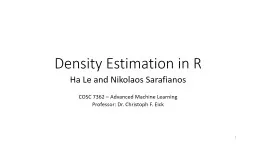PPT-PHIA Surveys: Sample Designs and Estimation Procedures
Author : min-jolicoeur | Published Date : 2018-01-15
Graham Kalton Westat PHIA sampling workshops This presentation provides a broad overview of the PHIA sampling and weighting issues The next two sampling workshop
Presentation Embed Code
Download Presentation
Download Presentation The PPT/PDF document "PHIA Surveys: Sample Designs and Estimat..." is the property of its rightful owner. Permission is granted to download and print the materials on this website for personal, non-commercial use only, and to display it on your personal computer provided you do not modify the materials and that you retain all copyright notices contained in the materials. By downloading content from our website, you accept the terms of this agreement.
PHIA Surveys: Sample Designs and Estimation Procedures: Transcript
Download Rules Of Document
"PHIA Surveys: Sample Designs and Estimation Procedures"The content belongs to its owner. You may download and print it for personal use, without modification, and keep all copyright notices. By downloading, you agree to these terms.
Related Documents














